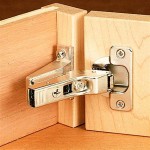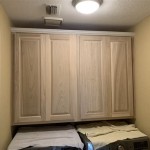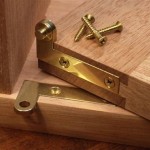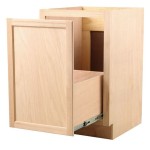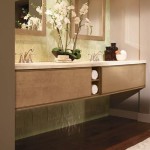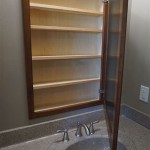How To Remove Sticky Grease From Wood Cabinets
Wood cabinets, especially those located near cooking areas, are highly susceptible to accumulating sticky grease. This grease, a combination of cooking oils, food splatters, and airborne dust, hardens over time, creating a stubborn and unsightly film. Regular cleaning is essential to maintain the aesthetic appeal and prolong the lifespan of wood cabinets. Effective grease removal requires understanding the composition of the grime, the type of wood finish, and utilizing appropriate cleaning methods and solutions.
The accumulation of sticky grease on wood cabinets not only detracts from their appearance but also poses a potential hygiene issue. Grease can harbor bacteria and attract pests. Furthermore, the hardened layer can make subsequent cleaning increasingly difficult. Ignoring the build-up can lead to permanent staining or damage to the wood finish, necessitating costly repairs or replacements. Routine maintenance, including regular wiping and occasional deep cleaning, is therefore crucial for preserving the integrity and visual appeal of wood cabinets.
Identifying the Wood Finish and Grease Severity
Before initiating any cleaning process, it is imperative to identify the type of finish applied to the wood cabinets. Common finishes include varnish, lacquer, polyurethane, and painted surfaces. Testing the cleaning solution on an inconspicuous area is a vital step to prevent any potential damage or discoloration. Understanding the finish type will dictate the appropriate cleaning agents and methods to employ. For example, delicate finishes may require gentler solutions and techniques compared to more durable coatings.
The severity of the grease build-up also plays a significant role in determining the cleaning approach. Light grease deposits can often be removed with mild detergents and warm water, while heavy, hardened grease may necessitate the use of stronger degreasers or specialized cleaning products. Furthermore, the age of the grease stain affects its tenacity and ease of removal. Fresh grease is generally easier to clean compared to grease that has been allowed to accumulate and harden over extended periods.
The location of the cabinets is also a factor. Cabinets directly above the stove or near frequently used appliances tend to accumulate grease more rapidly and require more frequent cleaning. Assessing the specific conditions and wear patterns of the cabinets allows for a tailored cleaning strategy, optimizing effectiveness and minimizing potential risks.
Effective Cleaning Solutions and Methods
Several cleaning solutions and methods can effectively remove sticky grease from wood cabinets. The choice of solution should align with the type of wood finish and the severity of the grease build-up. It is generally advisable to start with the mildest solution and progressively move towards stronger options if necessary.
One common and gentle solution is a mixture of warm water and dish soap. The dish soap acts as a surfactant, breaking down the grease molecules and allowing them to be easily rinsed away. Apply the soapy water with a soft cloth or sponge, gently scrubbing the affected areas. Avoid using abrasive sponges or scouring pads, as they can scratch the wood finish. Rinse thoroughly with clean water and dry with a soft cloth to prevent water spots.
Another effective solution is a mixture of baking soda and water. Baking soda is a mild abrasive and can help to loosen stubborn grease. Create a paste by mixing baking soda with a small amount of water. Apply the paste to the greasy areas, gently scrub, and then rinse with clean water. This method is particularly useful for removing grease from textured or intricately designed cabinet doors. Baking soda is often considered a more "natural" cleaning agent compared to some of the harsher chemicals found in commercial products.
For more stubborn grease deposits, a solution of vinegar and water can be used. Vinegar's acidity helps to dissolve grease and grime. Mix equal parts vinegar and water in a spray bottle. Spray the solution onto the greasy areas and allow it to sit for a few minutes. Wipe away the solution with a clean cloth. Be mindful of the concentration of vinegar, as excessive acidity can potentially damage certain wood finishes. Testing is always recommended.
Commercial degreasers are also available and can be effective for removing heavy grease build-up. However, it is crucial to select a degreaser specifically designed for wood surfaces. Read the product label carefully and follow the manufacturer's instructions. Always test the degreaser on an inconspicuous area before applying it to the entire cabinet. Proper ventilation is also essential when using commercial degreasers, as some may release fumes. Wear gloves to protect the skin from potential irritation.
Steam cleaning can also be an effective method for removing grease from wood cabinets, especially for cabinets with intricate designs or hard-to-reach areas. The steam loosens the grease, allowing it to be easily wiped away. However, it is important to use a low-pressure steam cleaner and avoid prolonged exposure to prevent water damage. Dry the cabinets thoroughly after steam cleaning.
Preventative Measures and Maintenance
Preventing grease build-up is essential for maintaining the cleanliness of wood cabinets and reducing the need for intensive cleaning. Implementing preventative measures can significantly extend the lifespan of the cabinets and preserve their aesthetic appeal.
Regular wiping of the cabinets with a damp cloth is a simple but effective way to remove grease and food splatters before they harden. Aim to wipe down the cabinets at least once a week, focusing on areas near the stove and cooking surfaces. Using a mild detergent solution periodically can further enhance the cleaning process.
Using a range hood while cooking is crucial for reducing the amount of grease and steam that accumulates on the cabinets. The range hood effectively captures airborne grease particles, preventing them from settling on surfaces. Ensure that the range hood is cleaned regularly to maintain its efficiency.
Consider using a backsplash behind the stove to protect the wall and cabinets from splatters. Backsplashes are available in a variety of materials, including tile, glass, and stainless steel, and can be easily cleaned. This barrier reduces the area susceptible to grease accumulation, simplifying routine maintenance.
Applying a protective coating to the cabinets can help to prevent grease from penetrating the wood finish. A coat of wax or polish can create a barrier that makes it easier to wipe away grease and grime. Choose a product specifically designed for wood cabinets and follow the manufacturer's instructions for application.
Proper ventilation in the kitchen is essential for reducing humidity and preventing the accumulation of grease and moisture. Open windows or use a ventilation fan when cooking to improve airflow. This helps to minimize the conditions that promote grease build-up.
Regularly cleaning the filters in the range hood is crucial for maintaining its performance. Clogged filters reduce the range hood's ability to capture grease and smoke. Clean or replace the filters according to the manufacturer's recommendations.
Avoid using harsh cleaning agents or abrasive materials on wood cabinets, as these can damage the finish. Opt for gentle cleaning solutions and soft cloths or sponges. Always test cleaning products on an inconspicuous area before applying them to the entire cabinet.
Addressing spills and splatters immediately is key to preventing them from hardening and becoming difficult to remove. Wipe up messes as soon as they occur to avoid the need for more intensive cleaning later. This proactive approach minimizes the long-term build-up of grease and grime.
Rearranging the kitchen layout can sometimes help to reduce grease accumulation on cabinets. Consider relocating frequently used appliances or cooking surfaces away from cabinets to minimize splatters. Strategically positioning items can contribute to a cleaner and more efficient kitchen environment.

How Remove Grease From Wood Kitchen Cabinets

How To Clean Kitchen Cabinets Everyday Skate

How To Clean Sticky Wood Kitchen Cabinets Easily Infinity

Removing Grease From Kitchen Cabinets Creative Homemaking

Best 4 Ways To Clean Greasy Kitchen Cabinets Rosene Toronto On

How To Easily Clean Sticky Wood Kitchen Cabinets Creative Homemaking

How To Quickly Clean Cabinets Remove Grease Gunk Andrea Jean

How To Remove Grease From Kitchen Cabinets 3 Methods Bob Vila

How To Clean Sticky Grease Off Kitchen Cabinets Ovenclean

How To Clean Sticky Grease Off Kitchen Cabinets Infinity
Related Posts


